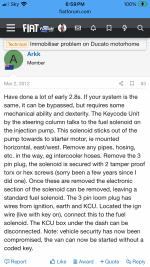scullynet
New member
i have a knaus Fiat Ducato motorhome. its a 1999 2.8d. i have owned this for 2 years with no problems.
It came with the red key when i bought it, i had another made and chip programmed i have used both on and off for 2 years.
I was away on friday on holiday in hexham. parked in a car park went bak an hour later and the key light ( imobiliser ) would not go off.
tried the usual fuses, took the cover off to get to sensor moved closer to key no luck. had to call AA could not fix it, got towed to garge near my house.
went this morning and started with the newer key no problems. Took old key to key shop and he said it was being red no problem. Went home to try it and still still would not work. Tried my good key same problem now. disscoceted battery went back a couple of hours later it was working but after trying it about 10 times its now not working.
ill probaly get an auto electrician out after the weekend unless anyone has something else to try thanks and regards Mark.
It came with the red key when i bought it, i had another made and chip programmed i have used both on and off for 2 years.
I was away on friday on holiday in hexham. parked in a car park went bak an hour later and the key light ( imobiliser ) would not go off.
tried the usual fuses, took the cover off to get to sensor moved closer to key no luck. had to call AA could not fix it, got towed to garge near my house.
went this morning and started with the newer key no problems. Took old key to key shop and he said it was being red no problem. Went home to try it and still still would not work. Tried my good key same problem now. disscoceted battery went back a couple of hours later it was working but after trying it about 10 times its now not working.
ill probaly get an auto electrician out after the weekend unless anyone has something else to try thanks and regards Mark.
- Model
- fiat ducato 2.8d


